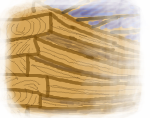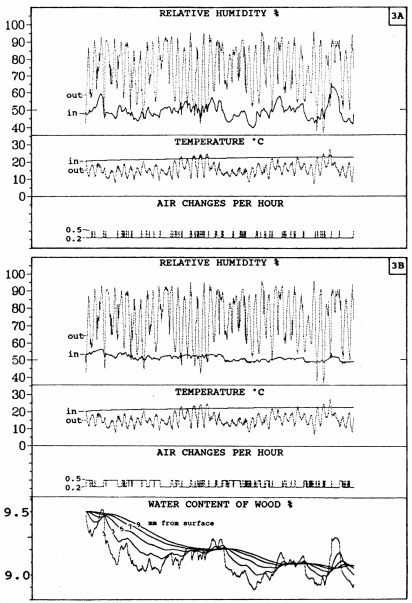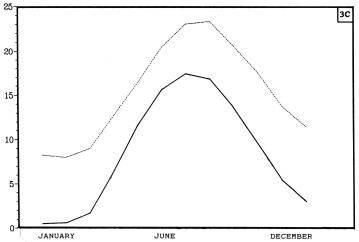
 |
Low energy climate control - 3 |

This method is similar to method 2 in that heat is used to lower the relative humidity, but, instead of reacting to the room climate, the control system imposes a room temperature calculated from the average outdoor climate.
In Denmark in June the average temperature is 15.6°C and the average relative humidity is 68%. If this average air is heated to 20.5°C the relative humidity will fall to 50%. If the room is held at this temperature the probability is that the RH will be 50% indoors. The buffer effect of the wood will hold the air near to this value during periods when the outside air is far from its average value. Furthermore the air exchange is shifted from 0.2 to 0.5 changes per hour when the outside air by chance has moisture content and temperature that would steer the room in the right direction. The monthly average outdoor temperature through the year and the corresponding indoor temperature that gives 50% RH are shown in fig. 3C. In Denmark the relative humidity so rarely falls below 50% that there is no need for artificial cooling. This method is not effective in a lightly loaded room because the length and severity of typical deviations from the monthly average are large enough to overcome the small thermal and moisture buffering effect of the wood. The method becomes more effective as the room fills up. In comparison with method 2 the temperature is of course much more even, the surface moisture content of the wood changes less violently but the internal moisture content is less stable, particularly as the "test reference year" has a cool period in mid summer. A disadvantage of the method is that the temperature is on average some seven degrees above ambient, which accelerates chemical degradation and encourages insect multiplication. Heating is needed throughout the year but energy consumption is smaller than in method 2 because there is no rapid temperature fluctuation.

Fig. 3C. The monthly average air temperature in Copenhagen (solid line). The upper, dotted line shows the temperature to which the air must be heated to give it a relative humidity of 50%.

This work is licensed under a Creative Commons Attribution-Noncommercial-No Derivative Works 3.0 License.